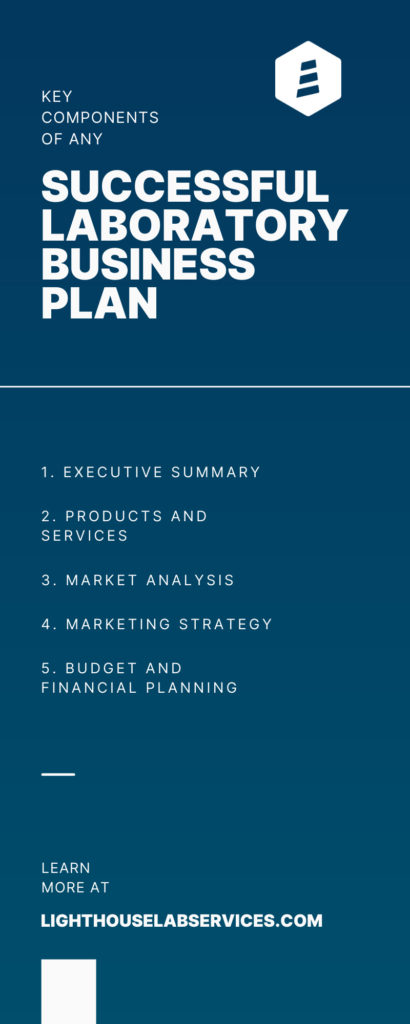One of the first steps you need to take to transform your ideas for a lab business into a functioning laboratory is to create a business plan. A business plan details your business’s objectives and how it will achieve its goals. Your business plan will help keep executive members focused on what’s good for the company and can help your business attract investments from external interests.
The document provides relevant marketing, financial, and operational information that explains how the business plans to achieve its goals. And just as your business changes and adapts, you will need to periodically revisit and revise your business plan to keep it current. Understand these key components of any successful laboratory business plan:
1. Executive Summary
 Since most detailed business plans run 15 to 20 pages long, the executive summary is a great way to highlight key points in the plan and pique the reader’s interest in your laboratory business. Summarize key points of your business plan in the executive summary. The executive summary appears at the beginning of the business plan and gives readers an overview of the entire document.
Since most detailed business plans run 15 to 20 pages long, the executive summary is a great way to highlight key points in the plan and pique the reader’s interest in your laboratory business. Summarize key points of your business plan in the executive summary. The executive summary appears at the beginning of the business plan and gives readers an overview of the entire document.
Your executive summary should include the following:
- The mission statement: a short statement, either a single sentence or short paragraph, that describes the company’s purpose of existence.
- The business opportunity: describe the need or opportunity the market presents and how your business meets the need or opportunity.
- The target market: the customer base you’re targeting. You can define your target market by checking out the competition, analyzing your products and services, and choosing specific demographics to serve.
- The products and services: describe what your business offers and how these products and services appeal to your target market.
- The marketing and sales strategy: briefly outline your plans for marketing your products and services. How will you generate interest in your laboratory and convert that interest into actual sales?
- The competition: What businesses do you compete with? Why will customers choose to use your business rather than your competitors’?
- Financial analysis: summarize the financial plan, including projections for at least the next three years. These projected statements are often called pro-forma financial statements, or simply pro-formas. They include the overall budget, current and projected financing needs, a market analysis, and the company’s marketing strategy.
- Owners and staff: describe the owners, key staff members, and their relevant expertise.
- Implementation plan: outline the steps and schedule for taking your business from the planning stage to a functioning laboratory.
The executive summary provides a lot of information, but remember to keep it short—no more than two pages long. One of the easiest ways to write the summary is to complete sections of your business plan, then write a couple of sentences summarizing each section. When readers have completely read through the executive summary, they should understand what your business does, how it does it, and how it stands above the competition.
2. Products and Services
In this section of your business plan, clearly describe the products and services you offer, including pricing and unique features and benefits. Explain the demand for your products and services. If pertinent, include information about manufacturing processes, your company’s intellectual property, proprietary technology, and details about research and development.
Include a paragraph or two about how your lab will process and fulfill customer orders. Describe specialized equipment your lab needs to create and deliver products. You can also explain future products or services you plan to offer.
3. Market Analysis
Market analysis is a key component of any successful laboratory business plan. That’s because the healthcare landscape changes constantly, and the success of your laboratory depends on how well you understand the market. When writing your market analysis, include information on your target market, your competition, and potential changes in the industry that could impact your business. Describe the expected consumer demand for your lab’s products, as well as how easy or difficult it might be to grab market share.
When determining your target market, consider factors such as age, gender, location, and income level. Understand what needs or problems your target market has that your laboratory can solve.
Your competition includes any other businesses that are offering similar products or services to your target market. Research your competition carefully. Find out what they’re offering, how much they’re charging, and their strengths and weaknesses. Knowing this information can help you differentiate your own products and services and make your business stand out.
Finally, stay aware of any potential changes in the medical industry that could impact your laboratory business. These could include new regulations, technological advances, or changing demographics. Understanding these potential changes can help your business adapt and stay ahead of the competition.
4. Marketing Strategy
In the marketing strategy section of your business plan, you’ll describe how your laboratory will attract and keep customers. Explain your marketing campaign ideas and how you plan to deliver marketing messages.
Once again, it’s important for you to know your target market well so that you can develop a plan to reach them. You can implement your strategy with traditional marketing tactics like print ads, direct mailers, and radio advertising. Or you can use or include more modern marketing methods, like social media marketing and search engine optimization.
Your marketing strategy will contain your business’s value proposition. This proposition introduces your brand to consumers and explains why your company deserves their business. The marketing strategy should address the four Ps of marketing: product, price, place, and promotion.
5. Budget and Financial Planning
The financial plan, the final piece in your business plan, discusses potential costs and how to manage them. This section will include financial planning and future projections. Established businesses often include statements and balance sheets in this section. New businesses discuss financial targets, estimates, and potential investors for the first few years.
Include a pro-forma that projects future income and expenses. The main components of a pro-forma are:
- Revenue: Money you expect to bring in from patients, healthcare providers, and insurance companies. Don’t forget potential revenue sources such as government contracts.
- Expenses: The cost of supplies, equipment, staff salaries, infrastructure, leasehold improvements, and technology.
- Profit: The difference between revenue and expenses.
The pro-forma statement can help you obtain financing from lenders and investors. It can also help you plan for years in the future and anticipate changes as your business grows.
Start Your Business with Lighthouse Lab Services
Starting any business can be tough, but creating a successful laboratory comes with unique challenges. If you’re starting a medical laboratory business, rely on the expertise of Lighthouse Lab Services.
We have built over 150 laboratories across the country. You can work with our team of experts from the initial consultation through the launch of your business. Contact us for a free consultation to get started!

Thank you for this good piece of information and guidance.
Thank you for your comment! Hearing this encourages us to keep writing more helpful articles for the medical laboratory industry.
I need to study the marketing plan for laboratory
A master piece of information. I am interested in opening a geologic laboratory as a private business
Glad you found this guide to be helpful! Good luck with your lab!